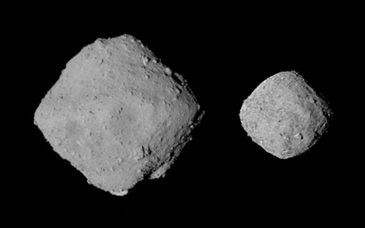Origin of two “cosmic diamonds” clarified

“Bennu” and “Ryugu” are two near-Earth asteroids with a diamond-like shape, the origin of which has long been a mystery. Now simulations of asteroid break-ups show how the special shape came about. The results could also help to better understand the processes involved in the formation of the Earth.
Around four and a half billion years ago, when our Solar System was still in its infancy, there was no Earth. It, along with the other planets in the system, was still spread on the so-called protoplanetary disc as dust. Over millennia, that dust slowly clumped together, forming ever larger objects. Those often violently collided, sometimes smashing each other to pieces, but with time, led to the formation of planetary building blocks and ultimately our home planet and its neighbours.

Even today, craters on the surface of celestial bodies bear witness to these collisions. This also applies to the two asteroids “Ryugu” and “Bennu”, as shown by images from the Hayabusa2 spacecraft of the Japan Aerospace Exploration Agency (JAXA) and the OSIRIS-REx mission of NASA. However, the two asteroids may not only have been affected by collisions, but even been created by them, according to a study just published in the journal Nature Communications. Martin Jutzi from the Institute of Physics at the University of Bern and the National Centre of Competence in Research PlanetS was involved in the research.
Common ancestry
The recent investigations showed not only, that both their shapes resemble spinning-tops, but also that they seem to be aggregates of rocks held together by gravity rather than single objects. They also appear to both be carbonaceous-type asteroids, meaning that their composition includes large amounts of carbon. These similarities led researchers to believe that Ryugu and Bennu originated from from larger asteroids, perhaps even the same object.

Images of Ryugu (left) and Bennu (right). They reveal their similar spinning top shape as well craters along their equatorial bulge. Credits: NASA, Univ. Arizona/JAXA, Univ. Tokyo.
But further observations showed that they also display differences. Most notably: different hydration levels. In other words: Ryugu appears to be drier than Bennu.
Heated impacts
If the two asteroids indeed originated from the same object, how then could the different hydration levels be explained, considering their distinct spinning-top shapes? This is where Martin Jutzi, researcher at PlanetS and the University of Bern came in.
“For the paper, I modelled the collisional break-ups of a potential parent asteroid, and calculated the level of compression of the resulting fragments”, he explains. With the help of his calculations, the team could show that the collision fragments could reaccrete to form the spinning-top shape. Previous studies had suggested that the shape originated through a thermal effect, accelerating the spin rate of the asteroid and resulting in an equatorward shift of material. But since this effect requires a long time to produce the spinning-top, it would have been difficult to reconcile with the craters, which indicate that the spinning-top shape was formed early in the asteroids’ histories. “Our results could thus offer a seemingly better explanation for the shape of the asteroids”, Jutzi explains.
Simulation of the asteroid break-up after the collision, from the immediate distribution of the particles that reaccrete to form the final spinning-top. Credits: Michel et al., 2020.
Jutzi and his colleagues also demonstrated that the fragments could experience different amounts of heating from the collisions. “We improved the accuracy of the calculated temperature increase that results from the impact shocks”, the scientist tells PlanetS. This heating is what drives the evaporation and loss of water within the minerals of the asteroids. Differential heating could thus explain differences in the loss of water and consequent hydration levels.
Further insights from samples
Material samples taken from the two asteroid sampling missions will enable the scientists to verify their results. The JAXA mission is currently on its way back to Earth. If everything goes as planned, it will deliver its samples of Ryugu by the end of the year. The NASA spacecraft will try collect its samples from Bennu in autumn and should bring them back to Earth in a little over three years’ time. The scientists hope that the samples will help them better understand the origins, formation and evolution not only of Ryugu and Bennu, as Martin Jutzi says: “By looking at these objects, we can ideally also improve our understanding of how the planetary building blocks evolved, that ultimately formed Earth”.
Reference: Michel, P., Ballouz, R., Barnouin, O.S. et al. Collisional formation of top-shaped asteroids and implications for the origins of Ryugu and Bennu. Nat Commun 11, 2655 (2020). https://doi.org/10.1038/s41467-020-16433-z

